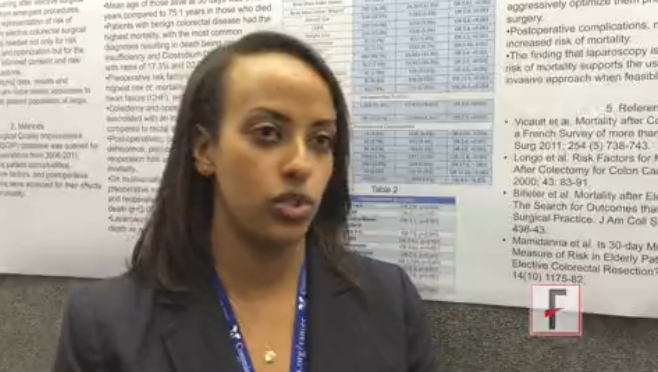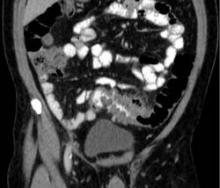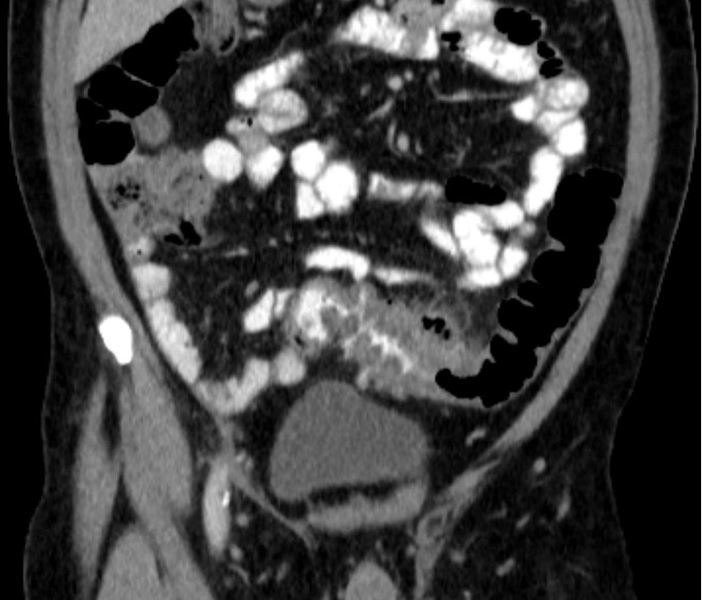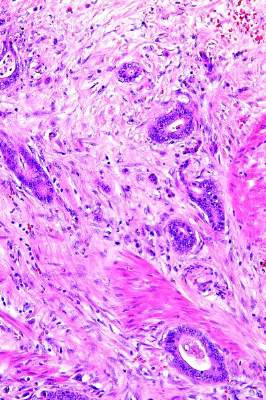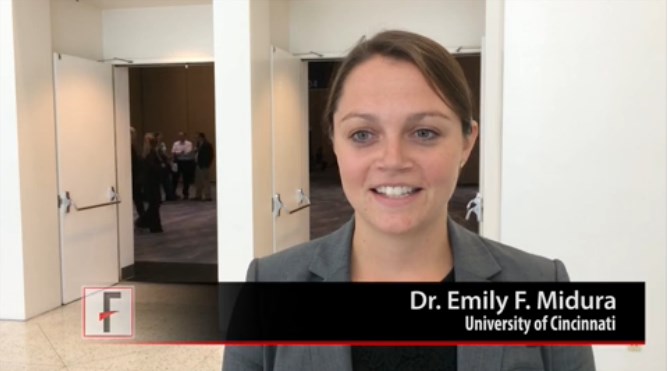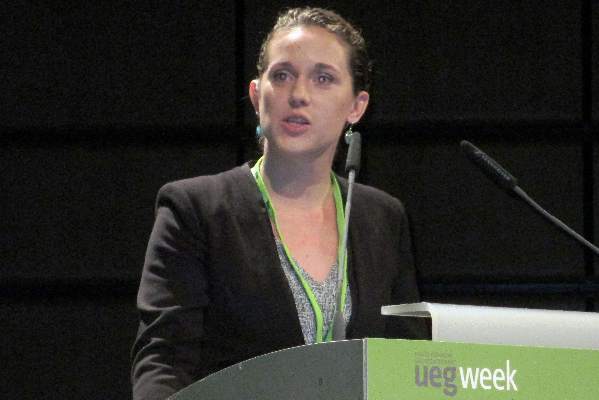User login
VIDEO: Mortality rate after elective colorectal surgery hits 2%
SAN FRANCISCO– Patients undergoing elective colorectal surgery had an overall mortality rate of 1.7% after 30 days, an analysis of data from 65,716 patients showed.
Patients with significant preoperative morbidity had a significantly higher risk of dying after the surgery, Dr. Alodia Gabre-Kidan and her associates reported at the annual clinical congress of the American College of Surgeons.
In a video interview, Dr. Gabre-Kidan discusses the results of the retrospective study, including the especially high risk for patients with preoperative renal failure or heart failure. The findings should help clinicians better counsel patients who are considering elective colorectal surgery, said Dr. Gabre-Kidan of Columbia University, New York.
Dr. Gabre-Kidan reporting having no financial disclosures.
On Twitter @sherryboschert
The video associated with this article is no longer available on this site. Please view all of our videos on the MDedge YouTube channel
SAN FRANCISCO– Patients undergoing elective colorectal surgery had an overall mortality rate of 1.7% after 30 days, an analysis of data from 65,716 patients showed.
Patients with significant preoperative morbidity had a significantly higher risk of dying after the surgery, Dr. Alodia Gabre-Kidan and her associates reported at the annual clinical congress of the American College of Surgeons.
In a video interview, Dr. Gabre-Kidan discusses the results of the retrospective study, including the especially high risk for patients with preoperative renal failure or heart failure. The findings should help clinicians better counsel patients who are considering elective colorectal surgery, said Dr. Gabre-Kidan of Columbia University, New York.
Dr. Gabre-Kidan reporting having no financial disclosures.
On Twitter @sherryboschert
The video associated with this article is no longer available on this site. Please view all of our videos on the MDedge YouTube channel
SAN FRANCISCO– Patients undergoing elective colorectal surgery had an overall mortality rate of 1.7% after 30 days, an analysis of data from 65,716 patients showed.
Patients with significant preoperative morbidity had a significantly higher risk of dying after the surgery, Dr. Alodia Gabre-Kidan and her associates reported at the annual clinical congress of the American College of Surgeons.
In a video interview, Dr. Gabre-Kidan discusses the results of the retrospective study, including the especially high risk for patients with preoperative renal failure or heart failure. The findings should help clinicians better counsel patients who are considering elective colorectal surgery, said Dr. Gabre-Kidan of Columbia University, New York.
Dr. Gabre-Kidan reporting having no financial disclosures.
On Twitter @sherryboschert
The video associated with this article is no longer available on this site. Please view all of our videos on the MDedge YouTube channel
AT THE ACS CLINICAL CONGRESS
Mismatch seen between trends in elective, emergent colectomies for diverticulitis
SAN FRANCISCO – Performance of more elective colectomies for diverticulitis in recent years does not seem to be preventing the need for emergent or urgent colectomies, investigators reported at the annual clinical congress of the American College of Surgeons.
The investigators analyzed data from the Comprehensive Hospital Abstract Reporting System (CHARS), a Washington State inpatient database, for the years 1987-2012.
Results showed that the age- and sex-adjusted rate of elective colectomies for diverticulitis increased from about 7 per 100,000 people to more than 20 per 100,000 people. But the rate of nonelective (emergent or urgent) colectomies for this indication remained fairly stable, if anything, increasing slightly.
“Despite 15 years of evolving guidelines to operate less, we are actually seeing a threefold increase in elective colectomy for diverticulitis. We did not see a decrease in emergency surgery during the same time,” commented lead investigator Dr. Vlad V. Simianu, a research fellow in the department of surgery, University of Washington, Seattle.
Several hypotheses might explain this disconnect, he proposed: a rising incidence of diverticulitis, increasing severity of disease (although data do not support this), or surgeons’ adoption of a lower threshold for elective colectomy. “In fact, if you look at where the biggest climb in elective surgery was, it was sort of in the early 2000s, which was the time contemporaneous to when the first laparoscopic colorectal randomized trials were being published, and training programs were incorporating laparoscopy into their training. That’s really where we see the biggest jump. So it may be that what we are seeing is an increase in this procedure [laparoscopic colectomy], the same as what we saw with laparoscopic cholecystectomy.”
“Whatever you choose ... to believe about what’s driving this, what remains certain going forward is that routine elective colectomy is not supported by the most recent guidelines [from the American Society of Colon and Rectal Surgeons], and actually these guidelines are for the first time recommending that the decision to offer elective surgery be individualized,” Dr. Simianu noted.
“Our group is actually doing some neat work in this space trying to identify which metrics should be used to individualize surgery, so we look forward to sharing that with you in the future,” he added.
Session comoderator Dr. James J. Mezhir of the University of Iowa, Iowa City, asked, “It may be difficult, but are you able to look at general surgeons versus those who are colorectal trained?”
The database does not specify surgeon training, according to Dr. Simianu, who disclosed that he had no relevant conflicts of interest. “What is interesting is that in Washington State, about half the surgery is done laparoscopically, in recent years at least. Whether laparoscopy is lowering the threshold, we know that colorectal surgeons are trained to do more laparoscopic colectomy maybe than their general surgeon counterparts.”
Another state database has provided some additional relevant information, he noted. “When laparoscopy first started being adopted, we saw a spike in right-sided colon surgery, which was previously a pretty rare colectomy for diverticulitis. So it is hard to know who is sort of driving this.”
Dr. Mezhir also wanted to know, “How generalizable is this across the United States? Have you looked at something like the nationwide inpatient sample or some other data set to say whether this is something you are seeing in Washington or is this something across the U.S.?”
Similar national trends have been reported in studies using that database, according to Dr. Simianu. “One of the things they point out is that there is a spike in diverticulitis in the younger population, which is something we are seeing in Washington State as well,” he noted.
Another session attendee noted that patients with acute diverticulitis sometimes have immediate procedures, such as drainage, but then go on to have colectomy not long afterward. Thus, he wondered about misclassification, asking, “Are you capturing it as elective although it’s sorted out as an acute episode?”
“That’s a great question, said another way, are we actually just delaying things into the elective category, as opposed to operating on them emergently?” Dr. Simianu replied. “It’s a little hard to tell. We do know that during this time, rates of percutaneous drainage have gone up. So it’s sort of the same conclusion that we are doing more elective surgery but we are not really preventing complications. But I think the crux of that is when these patients have complications and have emergency surgery, they have it on their first episode, 80%-90% of them. So offering a delayed operation ... to prevent [complications] where the likelihood is highest of having a complication, doesn’t seem to bear out in the data.”
SAN FRANCISCO – Performance of more elective colectomies for diverticulitis in recent years does not seem to be preventing the need for emergent or urgent colectomies, investigators reported at the annual clinical congress of the American College of Surgeons.
The investigators analyzed data from the Comprehensive Hospital Abstract Reporting System (CHARS), a Washington State inpatient database, for the years 1987-2012.
Results showed that the age- and sex-adjusted rate of elective colectomies for diverticulitis increased from about 7 per 100,000 people to more than 20 per 100,000 people. But the rate of nonelective (emergent or urgent) colectomies for this indication remained fairly stable, if anything, increasing slightly.
“Despite 15 years of evolving guidelines to operate less, we are actually seeing a threefold increase in elective colectomy for diverticulitis. We did not see a decrease in emergency surgery during the same time,” commented lead investigator Dr. Vlad V. Simianu, a research fellow in the department of surgery, University of Washington, Seattle.
Several hypotheses might explain this disconnect, he proposed: a rising incidence of diverticulitis, increasing severity of disease (although data do not support this), or surgeons’ adoption of a lower threshold for elective colectomy. “In fact, if you look at where the biggest climb in elective surgery was, it was sort of in the early 2000s, which was the time contemporaneous to when the first laparoscopic colorectal randomized trials were being published, and training programs were incorporating laparoscopy into their training. That’s really where we see the biggest jump. So it may be that what we are seeing is an increase in this procedure [laparoscopic colectomy], the same as what we saw with laparoscopic cholecystectomy.”
“Whatever you choose ... to believe about what’s driving this, what remains certain going forward is that routine elective colectomy is not supported by the most recent guidelines [from the American Society of Colon and Rectal Surgeons], and actually these guidelines are for the first time recommending that the decision to offer elective surgery be individualized,” Dr. Simianu noted.
“Our group is actually doing some neat work in this space trying to identify which metrics should be used to individualize surgery, so we look forward to sharing that with you in the future,” he added.
Session comoderator Dr. James J. Mezhir of the University of Iowa, Iowa City, asked, “It may be difficult, but are you able to look at general surgeons versus those who are colorectal trained?”
The database does not specify surgeon training, according to Dr. Simianu, who disclosed that he had no relevant conflicts of interest. “What is interesting is that in Washington State, about half the surgery is done laparoscopically, in recent years at least. Whether laparoscopy is lowering the threshold, we know that colorectal surgeons are trained to do more laparoscopic colectomy maybe than their general surgeon counterparts.”
Another state database has provided some additional relevant information, he noted. “When laparoscopy first started being adopted, we saw a spike in right-sided colon surgery, which was previously a pretty rare colectomy for diverticulitis. So it is hard to know who is sort of driving this.”
Dr. Mezhir also wanted to know, “How generalizable is this across the United States? Have you looked at something like the nationwide inpatient sample or some other data set to say whether this is something you are seeing in Washington or is this something across the U.S.?”
Similar national trends have been reported in studies using that database, according to Dr. Simianu. “One of the things they point out is that there is a spike in diverticulitis in the younger population, which is something we are seeing in Washington State as well,” he noted.
Another session attendee noted that patients with acute diverticulitis sometimes have immediate procedures, such as drainage, but then go on to have colectomy not long afterward. Thus, he wondered about misclassification, asking, “Are you capturing it as elective although it’s sorted out as an acute episode?”
“That’s a great question, said another way, are we actually just delaying things into the elective category, as opposed to operating on them emergently?” Dr. Simianu replied. “It’s a little hard to tell. We do know that during this time, rates of percutaneous drainage have gone up. So it’s sort of the same conclusion that we are doing more elective surgery but we are not really preventing complications. But I think the crux of that is when these patients have complications and have emergency surgery, they have it on their first episode, 80%-90% of them. So offering a delayed operation ... to prevent [complications] where the likelihood is highest of having a complication, doesn’t seem to bear out in the data.”
SAN FRANCISCO – Performance of more elective colectomies for diverticulitis in recent years does not seem to be preventing the need for emergent or urgent colectomies, investigators reported at the annual clinical congress of the American College of Surgeons.
The investigators analyzed data from the Comprehensive Hospital Abstract Reporting System (CHARS), a Washington State inpatient database, for the years 1987-2012.
Results showed that the age- and sex-adjusted rate of elective colectomies for diverticulitis increased from about 7 per 100,000 people to more than 20 per 100,000 people. But the rate of nonelective (emergent or urgent) colectomies for this indication remained fairly stable, if anything, increasing slightly.
“Despite 15 years of evolving guidelines to operate less, we are actually seeing a threefold increase in elective colectomy for diverticulitis. We did not see a decrease in emergency surgery during the same time,” commented lead investigator Dr. Vlad V. Simianu, a research fellow in the department of surgery, University of Washington, Seattle.
Several hypotheses might explain this disconnect, he proposed: a rising incidence of diverticulitis, increasing severity of disease (although data do not support this), or surgeons’ adoption of a lower threshold for elective colectomy. “In fact, if you look at where the biggest climb in elective surgery was, it was sort of in the early 2000s, which was the time contemporaneous to when the first laparoscopic colorectal randomized trials were being published, and training programs were incorporating laparoscopy into their training. That’s really where we see the biggest jump. So it may be that what we are seeing is an increase in this procedure [laparoscopic colectomy], the same as what we saw with laparoscopic cholecystectomy.”
“Whatever you choose ... to believe about what’s driving this, what remains certain going forward is that routine elective colectomy is not supported by the most recent guidelines [from the American Society of Colon and Rectal Surgeons], and actually these guidelines are for the first time recommending that the decision to offer elective surgery be individualized,” Dr. Simianu noted.
“Our group is actually doing some neat work in this space trying to identify which metrics should be used to individualize surgery, so we look forward to sharing that with you in the future,” he added.
Session comoderator Dr. James J. Mezhir of the University of Iowa, Iowa City, asked, “It may be difficult, but are you able to look at general surgeons versus those who are colorectal trained?”
The database does not specify surgeon training, according to Dr. Simianu, who disclosed that he had no relevant conflicts of interest. “What is interesting is that in Washington State, about half the surgery is done laparoscopically, in recent years at least. Whether laparoscopy is lowering the threshold, we know that colorectal surgeons are trained to do more laparoscopic colectomy maybe than their general surgeon counterparts.”
Another state database has provided some additional relevant information, he noted. “When laparoscopy first started being adopted, we saw a spike in right-sided colon surgery, which was previously a pretty rare colectomy for diverticulitis. So it is hard to know who is sort of driving this.”
Dr. Mezhir also wanted to know, “How generalizable is this across the United States? Have you looked at something like the nationwide inpatient sample or some other data set to say whether this is something you are seeing in Washington or is this something across the U.S.?”
Similar national trends have been reported in studies using that database, according to Dr. Simianu. “One of the things they point out is that there is a spike in diverticulitis in the younger population, which is something we are seeing in Washington State as well,” he noted.
Another session attendee noted that patients with acute diverticulitis sometimes have immediate procedures, such as drainage, but then go on to have colectomy not long afterward. Thus, he wondered about misclassification, asking, “Are you capturing it as elective although it’s sorted out as an acute episode?”
“That’s a great question, said another way, are we actually just delaying things into the elective category, as opposed to operating on them emergently?” Dr. Simianu replied. “It’s a little hard to tell. We do know that during this time, rates of percutaneous drainage have gone up. So it’s sort of the same conclusion that we are doing more elective surgery but we are not really preventing complications. But I think the crux of that is when these patients have complications and have emergency surgery, they have it on their first episode, 80%-90% of them. So offering a delayed operation ... to prevent [complications] where the likelihood is highest of having a complication, doesn’t seem to bear out in the data.”
AT THE ACS CLINICAL CONGRESS
Key clinical point: An increase in elective colectomies has not been accompanied by a decrease in emergent/urgent colectomies.
Major finding: The adjusted rate of elective colectomies tripled, but the rate of emergent/urgent colectomies remained stable.
Data source: A cohort study of colectomies for diverticulitis in Washington State between 1987 and 2012.
Disclosures: Dr. Simianu disclosed that he had no relevant conflicts of interest.
Perioperative fluid levels increase ileus risk
SAN FRANCISCO – Too much or too little IV fluid on the day of surgery was associated with a 10%-12% increased risk for postoperative ileus in a retrospective study of 84,722 patients undergoing colon surgery.
Patients who received more than 5 liters of IV fluid on the day of surgery had a 10% increased risk of postoperative ileus and patients who received no more than 1.7 L on the surgery had a 12% increased risk of postoperative ileus, compared with patients who received 1.71-5 L of fluid, Dr. Julie K. Marosky Thacker and her associates reported at the annual clinical congress of the American College of Surgeons.
“This is one of the first studies to show that in a U.S.-based review, we have a significant number of patients getting over 5 L of fluid on the day of colon operation,” and that both high and low fluids increase the risk of postoperative ileus, Dr. Thacker said. “Observed fluid use is not compliant with the recommendations that are widespread and described in the principles of Enhance Recovery After Surgery.”
Perhaps optimizing fluids could decrease postoperative ileus and improve outcomes, she added.
The observational study of data on adults undergoing colon surgery at 524 U.S. hospitals found a wide variation in the amount of IV fluids used on the day of surgery, ranging from none to more than 8 L, with a median of 3.1 L, Dr. Thacker of Duke University, Durham, N.C., said. The researchers defined excessive fluids as the highest quartile of fluid levels and low fluids as the lowest quartile.
Overall, 18% of patients developed postoperative ileus. The higher risk for ileus with low or high IV fluids on the day of surgery was seen in open and laparoscopic procedures.
Patients with ileus had significantly longer hospitalizations, higher costs, and increased likelihood of readmission, compared with patients without ileus. The hospital length of stay averaged 10 days with ileus and 6 days without ileus. Total costs averaged $20,734 per patient with ileus and $13,865 without ileus. Among patients with ileus, readmission rates were 14% within 30 days, 17% within 60 days, and 20% within 90 days. Among patients without ileus, readmission rates were 9%, 12%, and 14% at those time points, respectively.
Data for the study came from the Premier Data research database of a nationally representative sample of adult patients having colon surgery from January 1, 2008 through June 30, 2012. Procedures included laparoscopic partial excision of the large intestine, isolation of a segment of the large intestine, open and other partial excisions of the large intestine, total intra-abdominal colectomy, anastomosis of the small intestine to the rectal stump, and other small-to-large intestinal anastomoses.
Patients had a mean age of 62 years, 46% were male, and 73% were white. Forty-six percent of patients were covered by Medicare and 36% by managed care plans. Sixty-one percent of hospitals were nonteaching hospitals, and 89% were in an urban location.
The analysis adjusted for the influence of multiple other factors that may be associated with the risk of ileus, she said.
Deltex Medical, which markets fluid monitoring systems, funded the study. Dr. Thacker has been a consultant for Deltex and for Premier Data Inc., which acquired the data.
On Twitter @sherryboschert
SAN FRANCISCO – Too much or too little IV fluid on the day of surgery was associated with a 10%-12% increased risk for postoperative ileus in a retrospective study of 84,722 patients undergoing colon surgery.
Patients who received more than 5 liters of IV fluid on the day of surgery had a 10% increased risk of postoperative ileus and patients who received no more than 1.7 L on the surgery had a 12% increased risk of postoperative ileus, compared with patients who received 1.71-5 L of fluid, Dr. Julie K. Marosky Thacker and her associates reported at the annual clinical congress of the American College of Surgeons.
“This is one of the first studies to show that in a U.S.-based review, we have a significant number of patients getting over 5 L of fluid on the day of colon operation,” and that both high and low fluids increase the risk of postoperative ileus, Dr. Thacker said. “Observed fluid use is not compliant with the recommendations that are widespread and described in the principles of Enhance Recovery After Surgery.”
Perhaps optimizing fluids could decrease postoperative ileus and improve outcomes, she added.
The observational study of data on adults undergoing colon surgery at 524 U.S. hospitals found a wide variation in the amount of IV fluids used on the day of surgery, ranging from none to more than 8 L, with a median of 3.1 L, Dr. Thacker of Duke University, Durham, N.C., said. The researchers defined excessive fluids as the highest quartile of fluid levels and low fluids as the lowest quartile.
Overall, 18% of patients developed postoperative ileus. The higher risk for ileus with low or high IV fluids on the day of surgery was seen in open and laparoscopic procedures.
Patients with ileus had significantly longer hospitalizations, higher costs, and increased likelihood of readmission, compared with patients without ileus. The hospital length of stay averaged 10 days with ileus and 6 days without ileus. Total costs averaged $20,734 per patient with ileus and $13,865 without ileus. Among patients with ileus, readmission rates were 14% within 30 days, 17% within 60 days, and 20% within 90 days. Among patients without ileus, readmission rates were 9%, 12%, and 14% at those time points, respectively.
Data for the study came from the Premier Data research database of a nationally representative sample of adult patients having colon surgery from January 1, 2008 through June 30, 2012. Procedures included laparoscopic partial excision of the large intestine, isolation of a segment of the large intestine, open and other partial excisions of the large intestine, total intra-abdominal colectomy, anastomosis of the small intestine to the rectal stump, and other small-to-large intestinal anastomoses.
Patients had a mean age of 62 years, 46% were male, and 73% were white. Forty-six percent of patients were covered by Medicare and 36% by managed care plans. Sixty-one percent of hospitals were nonteaching hospitals, and 89% were in an urban location.
The analysis adjusted for the influence of multiple other factors that may be associated with the risk of ileus, she said.
Deltex Medical, which markets fluid monitoring systems, funded the study. Dr. Thacker has been a consultant for Deltex and for Premier Data Inc., which acquired the data.
On Twitter @sherryboschert
SAN FRANCISCO – Too much or too little IV fluid on the day of surgery was associated with a 10%-12% increased risk for postoperative ileus in a retrospective study of 84,722 patients undergoing colon surgery.
Patients who received more than 5 liters of IV fluid on the day of surgery had a 10% increased risk of postoperative ileus and patients who received no more than 1.7 L on the surgery had a 12% increased risk of postoperative ileus, compared with patients who received 1.71-5 L of fluid, Dr. Julie K. Marosky Thacker and her associates reported at the annual clinical congress of the American College of Surgeons.
“This is one of the first studies to show that in a U.S.-based review, we have a significant number of patients getting over 5 L of fluid on the day of colon operation,” and that both high and low fluids increase the risk of postoperative ileus, Dr. Thacker said. “Observed fluid use is not compliant with the recommendations that are widespread and described in the principles of Enhance Recovery After Surgery.”
Perhaps optimizing fluids could decrease postoperative ileus and improve outcomes, she added.
The observational study of data on adults undergoing colon surgery at 524 U.S. hospitals found a wide variation in the amount of IV fluids used on the day of surgery, ranging from none to more than 8 L, with a median of 3.1 L, Dr. Thacker of Duke University, Durham, N.C., said. The researchers defined excessive fluids as the highest quartile of fluid levels and low fluids as the lowest quartile.
Overall, 18% of patients developed postoperative ileus. The higher risk for ileus with low or high IV fluids on the day of surgery was seen in open and laparoscopic procedures.
Patients with ileus had significantly longer hospitalizations, higher costs, and increased likelihood of readmission, compared with patients without ileus. The hospital length of stay averaged 10 days with ileus and 6 days without ileus. Total costs averaged $20,734 per patient with ileus and $13,865 without ileus. Among patients with ileus, readmission rates were 14% within 30 days, 17% within 60 days, and 20% within 90 days. Among patients without ileus, readmission rates were 9%, 12%, and 14% at those time points, respectively.
Data for the study came from the Premier Data research database of a nationally representative sample of adult patients having colon surgery from January 1, 2008 through June 30, 2012. Procedures included laparoscopic partial excision of the large intestine, isolation of a segment of the large intestine, open and other partial excisions of the large intestine, total intra-abdominal colectomy, anastomosis of the small intestine to the rectal stump, and other small-to-large intestinal anastomoses.
Patients had a mean age of 62 years, 46% were male, and 73% were white. Forty-six percent of patients were covered by Medicare and 36% by managed care plans. Sixty-one percent of hospitals were nonteaching hospitals, and 89% were in an urban location.
The analysis adjusted for the influence of multiple other factors that may be associated with the risk of ileus, she said.
Deltex Medical, which markets fluid monitoring systems, funded the study. Dr. Thacker has been a consultant for Deltex and for Premier Data Inc., which acquired the data.
On Twitter @sherryboschert
AT THE ACS CLINICAL CONGRESS
Key clinical point: Giving no more than 1.7 liters or more than 5 liters of IV fluids on the day of surgery increased the risk of ileus.
Major finding: The ileus risk was 10% higher with excessive IV fluids and 12% higher with low fluids.
Data source: A retrospective observational cohort study of data on 84,722 patients undergoing colon surgery.
Disclosures: Deltex Medical, which markets fluid monitoring systems, funded the study. Dr. Thacker has been a consultant for Deltex and for Premier Data Inc., which acquired the data.
Palliative tumor removal extends survival
Palliative resection of the primary tumor actually extends survival in patients with metastatic colorectal adenocarcinoma, according to a report published online Nov. 4 in Annals of Surgery.
In what the investigators described as the first population-based study to assess trends in cancer-specific and overall survival among U.S. patients who did or did not undergo palliative removal of the primary tumor, the resection consistently conferred statistically significant and clinically meaningful survival benefits among 37,793 patients treated during a 12-year period.
“There is a heated debate in the medical and surgical oncology community regarding whether or not an asymptomatic primary tumor should be removed in patients with unresectable, synchronous cancer metastases,” wrote Dr. Ignazio Tarantino of the department of surgery, Kantonsspital St. Gallen (Switzerland) and the department of general, abdominal, and transplant surgery, University of Heidelberg (Germany) and his associates.
Current National Comprehensive Cancer Network guidelines recommend against palliative surgery in this setting, primarily because of evidence that leaving the primary tumor in situ seldom leads to life-threatening complications such as bleeding or bowel obstruction, while resection can cause complications and is not strictly necessary in terminally ill patients. But given these new findings of a significant survival benefit, “the dogma that [such tumors] never should be resected ... must be questioned,” the investigators wrote.
Dr. Tarantino and his associates analyzed Surveillance, Epidemiology, and End Results (SEER) data for 23,004 patients (60.9% of the total study population) who underwent primary tumor resection and 14,789 (39.1%) who did not. The percentage of patients who had the surgery steadily declined throughout the study period.
Palliative removal of the primary tumor was a significant protective factor for overall survival (HR of death, 0.49) and for cancer-specific survival (HR of cancer death, 0.49) in both the primary data analysis and a proportional hazard regression analysis.
Patients undergoing resection tended to be younger and healthier than those who did not have the procedure, so the researchers performed a propensity-score matching analysis to account for baseline differences between the two study groups. After adjustment for numerous potential confounders, palliative primary tumor resection continued to exert a significant protective effect for overall and cancer-specific survival, with HRs of 0.40 and 0.39, respectively. The survival benefit also persisted, with identical hazard ratios, in two further sensitivity analyses of the data, Dr. Tarantino and his associates noted (Ann. Surg. 2014 Nov. 4 [doi: 10.1097/SLA.0000000000000860]).
The mechanism by which palliative resection imparts a survival benefit is not yet known, they added.
Major advances in systemic treatment of metastatic colorectal cancer were achieved during the study period, and survival improved accordingly across both groups of patients over time. “Because of the improvement in systemic treatment, we anticipated that the differences in survival between the subsets of patients who did and who did not undergo palliative primary tumor resection would decrease over time. However – against our a priori hypothesis – our analysis demonstrates the contrary,” the investigators noted.
No financial or material support was provided for this study. Dr. Tarantino and his associates reported having no financial disclosures.
Palliative resection of the primary tumor actually extends survival in patients with metastatic colorectal adenocarcinoma, according to a report published online Nov. 4 in Annals of Surgery.
In what the investigators described as the first population-based study to assess trends in cancer-specific and overall survival among U.S. patients who did or did not undergo palliative removal of the primary tumor, the resection consistently conferred statistically significant and clinically meaningful survival benefits among 37,793 patients treated during a 12-year period.
“There is a heated debate in the medical and surgical oncology community regarding whether or not an asymptomatic primary tumor should be removed in patients with unresectable, synchronous cancer metastases,” wrote Dr. Ignazio Tarantino of the department of surgery, Kantonsspital St. Gallen (Switzerland) and the department of general, abdominal, and transplant surgery, University of Heidelberg (Germany) and his associates.
Current National Comprehensive Cancer Network guidelines recommend against palliative surgery in this setting, primarily because of evidence that leaving the primary tumor in situ seldom leads to life-threatening complications such as bleeding or bowel obstruction, while resection can cause complications and is not strictly necessary in terminally ill patients. But given these new findings of a significant survival benefit, “the dogma that [such tumors] never should be resected ... must be questioned,” the investigators wrote.
Dr. Tarantino and his associates analyzed Surveillance, Epidemiology, and End Results (SEER) data for 23,004 patients (60.9% of the total study population) who underwent primary tumor resection and 14,789 (39.1%) who did not. The percentage of patients who had the surgery steadily declined throughout the study period.
Palliative removal of the primary tumor was a significant protective factor for overall survival (HR of death, 0.49) and for cancer-specific survival (HR of cancer death, 0.49) in both the primary data analysis and a proportional hazard regression analysis.
Patients undergoing resection tended to be younger and healthier than those who did not have the procedure, so the researchers performed a propensity-score matching analysis to account for baseline differences between the two study groups. After adjustment for numerous potential confounders, palliative primary tumor resection continued to exert a significant protective effect for overall and cancer-specific survival, with HRs of 0.40 and 0.39, respectively. The survival benefit also persisted, with identical hazard ratios, in two further sensitivity analyses of the data, Dr. Tarantino and his associates noted (Ann. Surg. 2014 Nov. 4 [doi: 10.1097/SLA.0000000000000860]).
The mechanism by which palliative resection imparts a survival benefit is not yet known, they added.
Major advances in systemic treatment of metastatic colorectal cancer were achieved during the study period, and survival improved accordingly across both groups of patients over time. “Because of the improvement in systemic treatment, we anticipated that the differences in survival between the subsets of patients who did and who did not undergo palliative primary tumor resection would decrease over time. However – against our a priori hypothesis – our analysis demonstrates the contrary,” the investigators noted.
No financial or material support was provided for this study. Dr. Tarantino and his associates reported having no financial disclosures.
Palliative resection of the primary tumor actually extends survival in patients with metastatic colorectal adenocarcinoma, according to a report published online Nov. 4 in Annals of Surgery.
In what the investigators described as the first population-based study to assess trends in cancer-specific and overall survival among U.S. patients who did or did not undergo palliative removal of the primary tumor, the resection consistently conferred statistically significant and clinically meaningful survival benefits among 37,793 patients treated during a 12-year period.
“There is a heated debate in the medical and surgical oncology community regarding whether or not an asymptomatic primary tumor should be removed in patients with unresectable, synchronous cancer metastases,” wrote Dr. Ignazio Tarantino of the department of surgery, Kantonsspital St. Gallen (Switzerland) and the department of general, abdominal, and transplant surgery, University of Heidelberg (Germany) and his associates.
Current National Comprehensive Cancer Network guidelines recommend against palliative surgery in this setting, primarily because of evidence that leaving the primary tumor in situ seldom leads to life-threatening complications such as bleeding or bowel obstruction, while resection can cause complications and is not strictly necessary in terminally ill patients. But given these new findings of a significant survival benefit, “the dogma that [such tumors] never should be resected ... must be questioned,” the investigators wrote.
Dr. Tarantino and his associates analyzed Surveillance, Epidemiology, and End Results (SEER) data for 23,004 patients (60.9% of the total study population) who underwent primary tumor resection and 14,789 (39.1%) who did not. The percentage of patients who had the surgery steadily declined throughout the study period.
Palliative removal of the primary tumor was a significant protective factor for overall survival (HR of death, 0.49) and for cancer-specific survival (HR of cancer death, 0.49) in both the primary data analysis and a proportional hazard regression analysis.
Patients undergoing resection tended to be younger and healthier than those who did not have the procedure, so the researchers performed a propensity-score matching analysis to account for baseline differences between the two study groups. After adjustment for numerous potential confounders, palliative primary tumor resection continued to exert a significant protective effect for overall and cancer-specific survival, with HRs of 0.40 and 0.39, respectively. The survival benefit also persisted, with identical hazard ratios, in two further sensitivity analyses of the data, Dr. Tarantino and his associates noted (Ann. Surg. 2014 Nov. 4 [doi: 10.1097/SLA.0000000000000860]).
The mechanism by which palliative resection imparts a survival benefit is not yet known, they added.
Major advances in systemic treatment of metastatic colorectal cancer were achieved during the study period, and survival improved accordingly across both groups of patients over time. “Because of the improvement in systemic treatment, we anticipated that the differences in survival between the subsets of patients who did and who did not undergo palliative primary tumor resection would decrease over time. However – against our a priori hypothesis – our analysis demonstrates the contrary,” the investigators noted.
No financial or material support was provided for this study. Dr. Tarantino and his associates reported having no financial disclosures.
Key clinical point: Palliative removal of the primary tumor extends survival in patients with metastatic colorectal cancer.
Major finding: Palliative resection of the primary tumor was a significant protective factor for overall survival (HR of death, 0.49) and for cancer-specific survival (HR of cancer death, 0.49) in both the primary data analysis and a proportional hazard regression analysis.
Data source: A population-based study of the duration of survival in 23,004 patients with metastatic colorectal cancer who had palliative removal of the primary tumor and 14,789 who did not during a 12-year period.
Disclosures: No financial or material support was provided for this study. Dr. Tarantino and his associates reported having no disclosures.
Antibiotic bowel prep significantly reduces colon surgery infections
SAN FRANCISCO – Oral antibiotics with mechanical bowel preparation significantly reduce surgical site infections, length of hospital stay, and readmissions in both open and laparoscopic elective colorectal surgery, according to a review of 8,415 cases in the National Surgery Quality Improvement Program.
It “should be adopted for elective colorectal surgery,” concluded the investigators, led by colorectal surgeon Melanie Morris of the University of Alabama at Birmingham.
A quarter of the patients had no bowel prep, 45% had mechanical prep alone – GoLytely or another laxative, and 30% received both oral antibiotics and mechanical prep. Partial colectomy and sigmoid resections were the most common procedures, generally for neoplasms or diverticulitis.
Overall, 15% of the no-prep group, 12% of the mechanical prep group, and 6.5% of the oral antibiotic plus mechanical prep group developed subsequent surgical site infections (SSIs), a statistically significant difference. Results were similar when broken down into superficial, deep wound, and organ space infections (J. Am. Coll. Surg. 2014:219;S18-19).
On multivariate analysis and after adjusting for diabetes, smoking, age, and other potential confounders, the antibiotic group was 54% less likely than the no-prep group to develop an SSI (odds ratio 0.46), 26% less likely to be readmitted (OR 0.74), and more likely to leave the hospital earlier, at about 4 days instead of 5 (OR 0.90). SSIs and readmissions were only slightly less likely in the mechanical prep–only group, compared with the no-prep group, and there was no difference in length of stay.
There were fewer anastomotic leaks, fewer cases of sepsis, less significant bleeding, and other benefits for oral antibiotics with mechanical preparation. In addition, there was a protective effect against 30-day mortality in open procedures.
“Even in the minimally invasive group,” about two-thirds of patients, “oral antibiotic prep … was protective for surgical site infections,” Dr. Morris said at the annual clinical congress of the American College of Surgeons.
Still, bowel prep remains “a very controversial topic.” Nationwide some surgeons prep, some don’t. “People have very strong beliefs that may or may not be rooted in the data,” she said.
There are concerns about fluid and electrolyte disturbances, Clostridium difficile overgrowth, and other potential problems. Plus, mechanical preparation hasn’t worked any better than placebo in recent studies, but many of those studies didn’t include oral antibiotics. Effective bowel prep includes both, Dr. Morris said.
It’s possible that confounders might have been at work in the Alabama study. Perhaps surgeons shied away from bowel prep in older, sicker patients, but the rate of acute renal injury was the same in all three study groups at about 0.9%, suggesting similar background comorbidities.
“I don’t think confounding issues” explain the findings. Previously, “we’ve shown the benefit of oral antibiotic bowel prep in a [Veterans Affairs] cohort, and now we’ve shown it in this national cohort,” Dr. Morris said (Dis. Colon. Rectum 2012;55:1160-6).
After a marked reduction in surgical site infections in the VA study, “we changed our practices. We now do mechanical and oral antibiotic preps and have seen a 50% reduction in our SSI rate. We don’t feel like we are doing anything else differently,” she said.
Dr. Morris has no disclosures.
SAN FRANCISCO – Oral antibiotics with mechanical bowel preparation significantly reduce surgical site infections, length of hospital stay, and readmissions in both open and laparoscopic elective colorectal surgery, according to a review of 8,415 cases in the National Surgery Quality Improvement Program.
It “should be adopted for elective colorectal surgery,” concluded the investigators, led by colorectal surgeon Melanie Morris of the University of Alabama at Birmingham.
A quarter of the patients had no bowel prep, 45% had mechanical prep alone – GoLytely or another laxative, and 30% received both oral antibiotics and mechanical prep. Partial colectomy and sigmoid resections were the most common procedures, generally for neoplasms or diverticulitis.
Overall, 15% of the no-prep group, 12% of the mechanical prep group, and 6.5% of the oral antibiotic plus mechanical prep group developed subsequent surgical site infections (SSIs), a statistically significant difference. Results were similar when broken down into superficial, deep wound, and organ space infections (J. Am. Coll. Surg. 2014:219;S18-19).
On multivariate analysis and after adjusting for diabetes, smoking, age, and other potential confounders, the antibiotic group was 54% less likely than the no-prep group to develop an SSI (odds ratio 0.46), 26% less likely to be readmitted (OR 0.74), and more likely to leave the hospital earlier, at about 4 days instead of 5 (OR 0.90). SSIs and readmissions were only slightly less likely in the mechanical prep–only group, compared with the no-prep group, and there was no difference in length of stay.
There were fewer anastomotic leaks, fewer cases of sepsis, less significant bleeding, and other benefits for oral antibiotics with mechanical preparation. In addition, there was a protective effect against 30-day mortality in open procedures.
“Even in the minimally invasive group,” about two-thirds of patients, “oral antibiotic prep … was protective for surgical site infections,” Dr. Morris said at the annual clinical congress of the American College of Surgeons.
Still, bowel prep remains “a very controversial topic.” Nationwide some surgeons prep, some don’t. “People have very strong beliefs that may or may not be rooted in the data,” she said.
There are concerns about fluid and electrolyte disturbances, Clostridium difficile overgrowth, and other potential problems. Plus, mechanical preparation hasn’t worked any better than placebo in recent studies, but many of those studies didn’t include oral antibiotics. Effective bowel prep includes both, Dr. Morris said.
It’s possible that confounders might have been at work in the Alabama study. Perhaps surgeons shied away from bowel prep in older, sicker patients, but the rate of acute renal injury was the same in all three study groups at about 0.9%, suggesting similar background comorbidities.
“I don’t think confounding issues” explain the findings. Previously, “we’ve shown the benefit of oral antibiotic bowel prep in a [Veterans Affairs] cohort, and now we’ve shown it in this national cohort,” Dr. Morris said (Dis. Colon. Rectum 2012;55:1160-6).
After a marked reduction in surgical site infections in the VA study, “we changed our practices. We now do mechanical and oral antibiotic preps and have seen a 50% reduction in our SSI rate. We don’t feel like we are doing anything else differently,” she said.
Dr. Morris has no disclosures.
SAN FRANCISCO – Oral antibiotics with mechanical bowel preparation significantly reduce surgical site infections, length of hospital stay, and readmissions in both open and laparoscopic elective colorectal surgery, according to a review of 8,415 cases in the National Surgery Quality Improvement Program.
It “should be adopted for elective colorectal surgery,” concluded the investigators, led by colorectal surgeon Melanie Morris of the University of Alabama at Birmingham.
A quarter of the patients had no bowel prep, 45% had mechanical prep alone – GoLytely or another laxative, and 30% received both oral antibiotics and mechanical prep. Partial colectomy and sigmoid resections were the most common procedures, generally for neoplasms or diverticulitis.
Overall, 15% of the no-prep group, 12% of the mechanical prep group, and 6.5% of the oral antibiotic plus mechanical prep group developed subsequent surgical site infections (SSIs), a statistically significant difference. Results were similar when broken down into superficial, deep wound, and organ space infections (J. Am. Coll. Surg. 2014:219;S18-19).
On multivariate analysis and after adjusting for diabetes, smoking, age, and other potential confounders, the antibiotic group was 54% less likely than the no-prep group to develop an SSI (odds ratio 0.46), 26% less likely to be readmitted (OR 0.74), and more likely to leave the hospital earlier, at about 4 days instead of 5 (OR 0.90). SSIs and readmissions were only slightly less likely in the mechanical prep–only group, compared with the no-prep group, and there was no difference in length of stay.
There were fewer anastomotic leaks, fewer cases of sepsis, less significant bleeding, and other benefits for oral antibiotics with mechanical preparation. In addition, there was a protective effect against 30-day mortality in open procedures.
“Even in the minimally invasive group,” about two-thirds of patients, “oral antibiotic prep … was protective for surgical site infections,” Dr. Morris said at the annual clinical congress of the American College of Surgeons.
Still, bowel prep remains “a very controversial topic.” Nationwide some surgeons prep, some don’t. “People have very strong beliefs that may or may not be rooted in the data,” she said.
There are concerns about fluid and electrolyte disturbances, Clostridium difficile overgrowth, and other potential problems. Plus, mechanical preparation hasn’t worked any better than placebo in recent studies, but many of those studies didn’t include oral antibiotics. Effective bowel prep includes both, Dr. Morris said.
It’s possible that confounders might have been at work in the Alabama study. Perhaps surgeons shied away from bowel prep in older, sicker patients, but the rate of acute renal injury was the same in all three study groups at about 0.9%, suggesting similar background comorbidities.
“I don’t think confounding issues” explain the findings. Previously, “we’ve shown the benefit of oral antibiotic bowel prep in a [Veterans Affairs] cohort, and now we’ve shown it in this national cohort,” Dr. Morris said (Dis. Colon. Rectum 2012;55:1160-6).
After a marked reduction in surgical site infections in the VA study, “we changed our practices. We now do mechanical and oral antibiotic preps and have seen a 50% reduction in our SSI rate. We don’t feel like we are doing anything else differently,” she said.
Dr. Morris has no disclosures.
AT THE ACS CLINICAL CONGRESS
Key clinical point: Effective bowel prep must include oral antibiotics as well as laxatives.
Major finding: Prepping colorectal surgery patients with both oral antibiotics and laxatives halves the risk of surgery site infections (OR 0.46, 95% CI 0.36-0.59, P < .001),
Data source: Review of 8,415 cases in the National Surgery Quality Improvement Program
Disclosures: Dr. Morris has no relevant financial disclosures.
Low-stage colon cancers need to be followed post surgery for recurrence
SAN FRANCISCO – Patients with stage I colorectal cancer should be followed as closely as patients with higher-stage primary tumors after resection, according to a prospective 6-year surveillance study of 1,202 British patients.
The reason is that the incidence of recurrences that can be treated surgically with curative intent is the same in stage I patients as it is in patients with stage II and III primaries, about 6% (J. Am. Coll. Surg. 2014:219;e46-47).
Following resection with clear margins, the patients were randomized about 300 per group to either serial CT surveillance, serial carcinoembryonic antigen (CEA) monitoring, both, or minimum surveillance, and followed for a median of 4.4 years. About a quarter of the subjects had Dukes’ A primaries and a quarter Dukes’ C primaries, and about half had Dukes’ B primaries. The A, B, C designations are similar to the stage I, II, and III designations more common in the United States.
On both sides of the Atlantic, guidelines focus on active surveillance for higher-stage primaries, but are ambivalent about monitoring stage I tumors because they are less likely to recur and the benefit of follow-up has been uncertain.
That needs to change because treatable recurrences are what matters, and they are as likely in low-stage disease as in high-stage disease, lead investigator Dr. Sian Pugh, a colorectal surgeon at the University of Southampton (England), said at the annual clinical congress of the American College of Surgeons.
“Picking up recurrences that are not treatable doesn’t help anyone; it just gives you bad news earlier,” she said. The benefit of follow-up is “finding treatable disease, and that’s independent of the stage of the primary tumor. We recommend equivalent follow-up for all patients with resected Dukes’ A-C colorectal cancer. The guidelines [should] be reconsidered,” she asserted.
Her team also thinks that the most cost-effective way to monitor patients is probably with CEA monitoring every 3 months for the first 2 years, CEA monitoring every 6 months thereafter until year 5, and a single CT at 12-18 months to catch recurrences that don’t express CEA. That strategy was three times more likely than minimal surveillance to find treatable recurrences, about the same as serial CTs and serial CTs with regular CEA monitoring.
“We don’t think patients need to be followed up quite as intensively as the guidelines suggest,” – for instance, CT scans every 6 months – “but we are waiting for more health economic analysis,” Dr. Pugh said.
Although treatable recurrences were equally likely in all the groups, they were more common in patients with lower-stage primary cancers. Among recurrences in patients with Dukes’ A primary tumors, 50% (13/26) were treated surgically with curative intent, compared with 40% (32/81) in patients with Dukes’ B primaries and 24% (20/82) in those with Dukes’ C.
Pulmonary recurrence was most frequent with rectal primary tumors, and multisite recurrence was most common from right-colonic cancers. Median survival following recurrence was 2.28 years and was influenced by stage and site of primary. Following recurrence, survival was highest in those with lower-stage and rectal primaries, and lowest in patients with higher-stage primaries and recurrence from the right colon.
Dr. Pugh had no disclosures. The work was funded by the U.K. National Health Service.
There’s a lot of heterogeneity in the United States with regard to how frequently people get surveillance imaging and CEA for colon cancer recurrence. The study is helpful because it presents data that inform the decision.
These data suggest that CEA on a regular basis and a CT scan at 1 year are enough. This may be a more rational, cost-effective way to screen people and still achieve what we’re trying to achieve: picking up treatable recurrences.
Dr. Timothy Pawlik is chief of the division of surgical oncology and a professor of surgery at Johns Hopkins University, Baltimore.
There’s a lot of heterogeneity in the United States with regard to how frequently people get surveillance imaging and CEA for colon cancer recurrence. The study is helpful because it presents data that inform the decision.
These data suggest that CEA on a regular basis and a CT scan at 1 year are enough. This may be a more rational, cost-effective way to screen people and still achieve what we’re trying to achieve: picking up treatable recurrences.
Dr. Timothy Pawlik is chief of the division of surgical oncology and a professor of surgery at Johns Hopkins University, Baltimore.
There’s a lot of heterogeneity in the United States with regard to how frequently people get surveillance imaging and CEA for colon cancer recurrence. The study is helpful because it presents data that inform the decision.
These data suggest that CEA on a regular basis and a CT scan at 1 year are enough. This may be a more rational, cost-effective way to screen people and still achieve what we’re trying to achieve: picking up treatable recurrences.
Dr. Timothy Pawlik is chief of the division of surgical oncology and a professor of surgery at Johns Hopkins University, Baltimore.
SAN FRANCISCO – Patients with stage I colorectal cancer should be followed as closely as patients with higher-stage primary tumors after resection, according to a prospective 6-year surveillance study of 1,202 British patients.
The reason is that the incidence of recurrences that can be treated surgically with curative intent is the same in stage I patients as it is in patients with stage II and III primaries, about 6% (J. Am. Coll. Surg. 2014:219;e46-47).
Following resection with clear margins, the patients were randomized about 300 per group to either serial CT surveillance, serial carcinoembryonic antigen (CEA) monitoring, both, or minimum surveillance, and followed for a median of 4.4 years. About a quarter of the subjects had Dukes’ A primaries and a quarter Dukes’ C primaries, and about half had Dukes’ B primaries. The A, B, C designations are similar to the stage I, II, and III designations more common in the United States.
On both sides of the Atlantic, guidelines focus on active surveillance for higher-stage primaries, but are ambivalent about monitoring stage I tumors because they are less likely to recur and the benefit of follow-up has been uncertain.
That needs to change because treatable recurrences are what matters, and they are as likely in low-stage disease as in high-stage disease, lead investigator Dr. Sian Pugh, a colorectal surgeon at the University of Southampton (England), said at the annual clinical congress of the American College of Surgeons.
“Picking up recurrences that are not treatable doesn’t help anyone; it just gives you bad news earlier,” she said. The benefit of follow-up is “finding treatable disease, and that’s independent of the stage of the primary tumor. We recommend equivalent follow-up for all patients with resected Dukes’ A-C colorectal cancer. The guidelines [should] be reconsidered,” she asserted.
Her team also thinks that the most cost-effective way to monitor patients is probably with CEA monitoring every 3 months for the first 2 years, CEA monitoring every 6 months thereafter until year 5, and a single CT at 12-18 months to catch recurrences that don’t express CEA. That strategy was three times more likely than minimal surveillance to find treatable recurrences, about the same as serial CTs and serial CTs with regular CEA monitoring.
“We don’t think patients need to be followed up quite as intensively as the guidelines suggest,” – for instance, CT scans every 6 months – “but we are waiting for more health economic analysis,” Dr. Pugh said.
Although treatable recurrences were equally likely in all the groups, they were more common in patients with lower-stage primary cancers. Among recurrences in patients with Dukes’ A primary tumors, 50% (13/26) were treated surgically with curative intent, compared with 40% (32/81) in patients with Dukes’ B primaries and 24% (20/82) in those with Dukes’ C.
Pulmonary recurrence was most frequent with rectal primary tumors, and multisite recurrence was most common from right-colonic cancers. Median survival following recurrence was 2.28 years and was influenced by stage and site of primary. Following recurrence, survival was highest in those with lower-stage and rectal primaries, and lowest in patients with higher-stage primaries and recurrence from the right colon.
Dr. Pugh had no disclosures. The work was funded by the U.K. National Health Service.
SAN FRANCISCO – Patients with stage I colorectal cancer should be followed as closely as patients with higher-stage primary tumors after resection, according to a prospective 6-year surveillance study of 1,202 British patients.
The reason is that the incidence of recurrences that can be treated surgically with curative intent is the same in stage I patients as it is in patients with stage II and III primaries, about 6% (J. Am. Coll. Surg. 2014:219;e46-47).
Following resection with clear margins, the patients were randomized about 300 per group to either serial CT surveillance, serial carcinoembryonic antigen (CEA) monitoring, both, or minimum surveillance, and followed for a median of 4.4 years. About a quarter of the subjects had Dukes’ A primaries and a quarter Dukes’ C primaries, and about half had Dukes’ B primaries. The A, B, C designations are similar to the stage I, II, and III designations more common in the United States.
On both sides of the Atlantic, guidelines focus on active surveillance for higher-stage primaries, but are ambivalent about monitoring stage I tumors because they are less likely to recur and the benefit of follow-up has been uncertain.
That needs to change because treatable recurrences are what matters, and they are as likely in low-stage disease as in high-stage disease, lead investigator Dr. Sian Pugh, a colorectal surgeon at the University of Southampton (England), said at the annual clinical congress of the American College of Surgeons.
“Picking up recurrences that are not treatable doesn’t help anyone; it just gives you bad news earlier,” she said. The benefit of follow-up is “finding treatable disease, and that’s independent of the stage of the primary tumor. We recommend equivalent follow-up for all patients with resected Dukes’ A-C colorectal cancer. The guidelines [should] be reconsidered,” she asserted.
Her team also thinks that the most cost-effective way to monitor patients is probably with CEA monitoring every 3 months for the first 2 years, CEA monitoring every 6 months thereafter until year 5, and a single CT at 12-18 months to catch recurrences that don’t express CEA. That strategy was three times more likely than minimal surveillance to find treatable recurrences, about the same as serial CTs and serial CTs with regular CEA monitoring.
“We don’t think patients need to be followed up quite as intensively as the guidelines suggest,” – for instance, CT scans every 6 months – “but we are waiting for more health economic analysis,” Dr. Pugh said.
Although treatable recurrences were equally likely in all the groups, they were more common in patients with lower-stage primary cancers. Among recurrences in patients with Dukes’ A primary tumors, 50% (13/26) were treated surgically with curative intent, compared with 40% (32/81) in patients with Dukes’ B primaries and 24% (20/82) in those with Dukes’ C.
Pulmonary recurrence was most frequent with rectal primary tumors, and multisite recurrence was most common from right-colonic cancers. Median survival following recurrence was 2.28 years and was influenced by stage and site of primary. Following recurrence, survival was highest in those with lower-stage and rectal primaries, and lowest in patients with higher-stage primaries and recurrence from the right colon.
Dr. Pugh had no disclosures. The work was funded by the U.K. National Health Service.
Key clinical point: The incidence of treatable recurrence is the same regardless of the stage of the primary colon tumor.
Major finding: Six percent of recurrent stage I, II, and III colon cancers can be treated surgically with curative intent.
Data source: Randomized surveillance study of 1,202 British colon cancer patients after removal of their primary tumors.
Disclosures: Dr. Pugh had no disclosures. The work was funded by the U.K. National Health Service.
Fellow involvement is linked to better outcomes of colorectal surgery
SAN FRANCISCO – Patients undergoing colorectal surgery have lower rates of complications and are 20% less likely to die if a fellow is involved in the surgery as compared with a senior resident, new data show.
“Advanced trainee level was associated with improved outcomes in colorectal surgery,” first author Dr. Lilian Chen concluded at the annual clinical congress of the American College of Surgeons, where she presented the data.
“Future studies should attempt to delineate the relative contributions of trainees on intraoperative and postoperative patient care and effects on outcome, and perhaps emphasis on appropriate case selection and resident involvement to optimize patient outcomes,” she recommended.
Using data from the National Surgical Quality Improvement Program (NSQIP), the investigators analyzed outcomes of 68,327 common open and laparoscopic abdominal colorectal operations done during 2005-2012 in which trainees participated.
Outcomes were compared for junior residents in postgraduate years 1 through 3 (involved in 23% of surgeries), senior residents in postgraduate years 4 and 5 (61%), and fellows in postgraduate years beyond year 5 (16%).
The prevalence of many surgical risk factors differed significantly across the three groups of trainees, but most differences were not considered clinically important, according to Dr. Chen, who is a fellow at the Lahey Hospital and Medical Center in Burlington, Mass. “The exceptions were systemic sepsis and emergency cases, where it appears that the fellows are doing proportionately less of these cases,” she noted.
Rates of several 30-day outcomes – septic shock, stroke, unplanned intubation, postoperative pneumonia, wound disruption, acute renal failure, deep incisional surgical site infection, and return to the operating room – differed significantly across groups, being less common for fellows than for either resident group.
The rate of mortality also differed significantly, at 2% for fellows but 4% each for junior and senior residents. In multivariate analysis, patients were significantly less likely to die if a fellow was involved in their surgery as compared with a senior resident (odds ratio, 0.80), but there was no significant difference between junior and senior residents.
“Our limitations include the retrospective analysis, and our inability to adjust for the type of hospital and training program, attending surgeon experience, the presence of subspecialty training in those programs, and the actual level of involvement of the trainee in intraoperative as well as postoperative care of patients,” acknowledged Dr. Chen, who disclosed that she had no relevant conflicts of interest.
Indeed, several session attendees took issue with potential confounders. Dr. Mary T. Hawn, chief of Gastrointestinal Surgery at the University of Alabama at Birmingham, commented, “I think you have to be really careful about understanding the data that you are working with. The first thing is that you can’t adjust for hospital characteristics, so you don’t know that a patient didn’t get transferred to a higher level of care, where there are residents available. ...
“So, I would say you should exclude all emergency cases, you should exclude all patients who are transferred, and things like that, and really try to do propensity adjustment or [seek] some reason that might explain what level of trainee is involved,” she recommended, noting that adjustment does not rule out a role for that factor. “I think this is really concerning because it’s harmful to our community programs to publish data like these, where we don’t really understand the true involvement or the mechanisms of why having the trainee there might be associated with higher mortality.”
Another attendee agreed, saying, “If I’m doing a case with a fellow, I’m going to let the fellow do it, and perhaps assisting, sometimes watching, while I let the fellow do it with the junior resident. If I’m in there with the junior resident, I’m doing the case while the junior resident is assisting me. So I think you need to take things like that into account when you think about what your data actually mean.”
Residents are commonly involved in nighttime emergency cases because the fellow is not at the hospital, a third attendee noted. Additionally, “the fellows will tend to cherry-pick the cases they want to do. The fellow is going to be involved in the cases that are more likely to be quality elective cases. So the diabetic on oxygen who’s coming in for the right colon is potentially going to get handed over to someone else to pick it up. So I would agree, I think that just publishing this and having that as your statement can be very harmful. You really need to be very objective and truthful about owning up to these confounding factors that you can’t really measure.”
“I have to completely agree with that, there are certainly things that we can’t prove. All we can say is that fellows are associated with this reduction in mortality, but we can’t say why ... ” Dr. Chen concurred. “I can’t say the fellow is the reason. There are too many variables involved, one of those being that if you have a colorectal fellow, you are probably at a specialty center with a colorectal fellowship or oncology fellowship and that could be the reason why you have lower mortality, better outcomes. It is just because of the staff and the facility that’s equipped to take those complex cases. So it could have nothing to do with the fellows at all.”
SAN FRANCISCO – Patients undergoing colorectal surgery have lower rates of complications and are 20% less likely to die if a fellow is involved in the surgery as compared with a senior resident, new data show.
“Advanced trainee level was associated with improved outcomes in colorectal surgery,” first author Dr. Lilian Chen concluded at the annual clinical congress of the American College of Surgeons, where she presented the data.
“Future studies should attempt to delineate the relative contributions of trainees on intraoperative and postoperative patient care and effects on outcome, and perhaps emphasis on appropriate case selection and resident involvement to optimize patient outcomes,” she recommended.
Using data from the National Surgical Quality Improvement Program (NSQIP), the investigators analyzed outcomes of 68,327 common open and laparoscopic abdominal colorectal operations done during 2005-2012 in which trainees participated.
Outcomes were compared for junior residents in postgraduate years 1 through 3 (involved in 23% of surgeries), senior residents in postgraduate years 4 and 5 (61%), and fellows in postgraduate years beyond year 5 (16%).
The prevalence of many surgical risk factors differed significantly across the three groups of trainees, but most differences were not considered clinically important, according to Dr. Chen, who is a fellow at the Lahey Hospital and Medical Center in Burlington, Mass. “The exceptions were systemic sepsis and emergency cases, where it appears that the fellows are doing proportionately less of these cases,” she noted.
Rates of several 30-day outcomes – septic shock, stroke, unplanned intubation, postoperative pneumonia, wound disruption, acute renal failure, deep incisional surgical site infection, and return to the operating room – differed significantly across groups, being less common for fellows than for either resident group.
The rate of mortality also differed significantly, at 2% for fellows but 4% each for junior and senior residents. In multivariate analysis, patients were significantly less likely to die if a fellow was involved in their surgery as compared with a senior resident (odds ratio, 0.80), but there was no significant difference between junior and senior residents.
“Our limitations include the retrospective analysis, and our inability to adjust for the type of hospital and training program, attending surgeon experience, the presence of subspecialty training in those programs, and the actual level of involvement of the trainee in intraoperative as well as postoperative care of patients,” acknowledged Dr. Chen, who disclosed that she had no relevant conflicts of interest.
Indeed, several session attendees took issue with potential confounders. Dr. Mary T. Hawn, chief of Gastrointestinal Surgery at the University of Alabama at Birmingham, commented, “I think you have to be really careful about understanding the data that you are working with. The first thing is that you can’t adjust for hospital characteristics, so you don’t know that a patient didn’t get transferred to a higher level of care, where there are residents available. ...
“So, I would say you should exclude all emergency cases, you should exclude all patients who are transferred, and things like that, and really try to do propensity adjustment or [seek] some reason that might explain what level of trainee is involved,” she recommended, noting that adjustment does not rule out a role for that factor. “I think this is really concerning because it’s harmful to our community programs to publish data like these, where we don’t really understand the true involvement or the mechanisms of why having the trainee there might be associated with higher mortality.”
Another attendee agreed, saying, “If I’m doing a case with a fellow, I’m going to let the fellow do it, and perhaps assisting, sometimes watching, while I let the fellow do it with the junior resident. If I’m in there with the junior resident, I’m doing the case while the junior resident is assisting me. So I think you need to take things like that into account when you think about what your data actually mean.”
Residents are commonly involved in nighttime emergency cases because the fellow is not at the hospital, a third attendee noted. Additionally, “the fellows will tend to cherry-pick the cases they want to do. The fellow is going to be involved in the cases that are more likely to be quality elective cases. So the diabetic on oxygen who’s coming in for the right colon is potentially going to get handed over to someone else to pick it up. So I would agree, I think that just publishing this and having that as your statement can be very harmful. You really need to be very objective and truthful about owning up to these confounding factors that you can’t really measure.”
“I have to completely agree with that, there are certainly things that we can’t prove. All we can say is that fellows are associated with this reduction in mortality, but we can’t say why ... ” Dr. Chen concurred. “I can’t say the fellow is the reason. There are too many variables involved, one of those being that if you have a colorectal fellow, you are probably at a specialty center with a colorectal fellowship or oncology fellowship and that could be the reason why you have lower mortality, better outcomes. It is just because of the staff and the facility that’s equipped to take those complex cases. So it could have nothing to do with the fellows at all.”
SAN FRANCISCO – Patients undergoing colorectal surgery have lower rates of complications and are 20% less likely to die if a fellow is involved in the surgery as compared with a senior resident, new data show.
“Advanced trainee level was associated with improved outcomes in colorectal surgery,” first author Dr. Lilian Chen concluded at the annual clinical congress of the American College of Surgeons, where she presented the data.
“Future studies should attempt to delineate the relative contributions of trainees on intraoperative and postoperative patient care and effects on outcome, and perhaps emphasis on appropriate case selection and resident involvement to optimize patient outcomes,” she recommended.
Using data from the National Surgical Quality Improvement Program (NSQIP), the investigators analyzed outcomes of 68,327 common open and laparoscopic abdominal colorectal operations done during 2005-2012 in which trainees participated.
Outcomes were compared for junior residents in postgraduate years 1 through 3 (involved in 23% of surgeries), senior residents in postgraduate years 4 and 5 (61%), and fellows in postgraduate years beyond year 5 (16%).
The prevalence of many surgical risk factors differed significantly across the three groups of trainees, but most differences were not considered clinically important, according to Dr. Chen, who is a fellow at the Lahey Hospital and Medical Center in Burlington, Mass. “The exceptions were systemic sepsis and emergency cases, where it appears that the fellows are doing proportionately less of these cases,” she noted.
Rates of several 30-day outcomes – septic shock, stroke, unplanned intubation, postoperative pneumonia, wound disruption, acute renal failure, deep incisional surgical site infection, and return to the operating room – differed significantly across groups, being less common for fellows than for either resident group.
The rate of mortality also differed significantly, at 2% for fellows but 4% each for junior and senior residents. In multivariate analysis, patients were significantly less likely to die if a fellow was involved in their surgery as compared with a senior resident (odds ratio, 0.80), but there was no significant difference between junior and senior residents.
“Our limitations include the retrospective analysis, and our inability to adjust for the type of hospital and training program, attending surgeon experience, the presence of subspecialty training in those programs, and the actual level of involvement of the trainee in intraoperative as well as postoperative care of patients,” acknowledged Dr. Chen, who disclosed that she had no relevant conflicts of interest.
Indeed, several session attendees took issue with potential confounders. Dr. Mary T. Hawn, chief of Gastrointestinal Surgery at the University of Alabama at Birmingham, commented, “I think you have to be really careful about understanding the data that you are working with. The first thing is that you can’t adjust for hospital characteristics, so you don’t know that a patient didn’t get transferred to a higher level of care, where there are residents available. ...
“So, I would say you should exclude all emergency cases, you should exclude all patients who are transferred, and things like that, and really try to do propensity adjustment or [seek] some reason that might explain what level of trainee is involved,” she recommended, noting that adjustment does not rule out a role for that factor. “I think this is really concerning because it’s harmful to our community programs to publish data like these, where we don’t really understand the true involvement or the mechanisms of why having the trainee there might be associated with higher mortality.”
Another attendee agreed, saying, “If I’m doing a case with a fellow, I’m going to let the fellow do it, and perhaps assisting, sometimes watching, while I let the fellow do it with the junior resident. If I’m in there with the junior resident, I’m doing the case while the junior resident is assisting me. So I think you need to take things like that into account when you think about what your data actually mean.”
Residents are commonly involved in nighttime emergency cases because the fellow is not at the hospital, a third attendee noted. Additionally, “the fellows will tend to cherry-pick the cases they want to do. The fellow is going to be involved in the cases that are more likely to be quality elective cases. So the diabetic on oxygen who’s coming in for the right colon is potentially going to get handed over to someone else to pick it up. So I would agree, I think that just publishing this and having that as your statement can be very harmful. You really need to be very objective and truthful about owning up to these confounding factors that you can’t really measure.”
“I have to completely agree with that, there are certainly things that we can’t prove. All we can say is that fellows are associated with this reduction in mortality, but we can’t say why ... ” Dr. Chen concurred. “I can’t say the fellow is the reason. There are too many variables involved, one of those being that if you have a colorectal fellow, you are probably at a specialty center with a colorectal fellowship or oncology fellowship and that could be the reason why you have lower mortality, better outcomes. It is just because of the staff and the facility that’s equipped to take those complex cases. So it could have nothing to do with the fellows at all.”
AT THE ACS CLINICAL CONGRESS
Key clinical point: Morbidity and mortality were lower with fellows involved than with residents involved.
Major finding: Patients were less likely to have complications and 20% less likely to die when a fellow was involved with the surgery as compared with a senior resident.
Data source: A retrospective cohort study of 68,327 colorectal surgeries from the NSQIP database.
Disclosures: Dr. Chen disclosed that she had no relevant conflicts of interest.
VIDEO: Risks for anastomotic leak after colectomy identified
SAN FRANCISCO– A large retrospective study identified risk factors for anastomotic leak within 30 days of colectomy.
The analysis of data on 13,684 patients looked at a multicenter cohort, compared with previous smaller studies that generally focused on single institutions, Dr. Emily F. Midura and her associates reported at the annual clinical congress of the American College of Surgeons.
In a video interview at the meeting, Dr. Midura described the risk factors identified in the study.
The 4% of patients who developed a leak averaged 13 days in the hospital, compared with 8 days for patients with no leak, said Dr. Midura of the University of Cincinnati. A total of 6% of patients who developed an anastomotic leak died, compared with a 2% mortality rate in patients without a leak.
Indications for colectomy included cancer in 42% of patients, diverticulitis in 23%, inflammatory bowel disease in 6%, and other reasons in the rest of the cohort.
Dr. Midura reported having no financial disclosures.
The video associated with this article is no longer available on this site. Please view all of our videos on the MDedge YouTube channel
On Twitter @sherryboschert
SAN FRANCISCO– A large retrospective study identified risk factors for anastomotic leak within 30 days of colectomy.
The analysis of data on 13,684 patients looked at a multicenter cohort, compared with previous smaller studies that generally focused on single institutions, Dr. Emily F. Midura and her associates reported at the annual clinical congress of the American College of Surgeons.
In a video interview at the meeting, Dr. Midura described the risk factors identified in the study.
The 4% of patients who developed a leak averaged 13 days in the hospital, compared with 8 days for patients with no leak, said Dr. Midura of the University of Cincinnati. A total of 6% of patients who developed an anastomotic leak died, compared with a 2% mortality rate in patients without a leak.
Indications for colectomy included cancer in 42% of patients, diverticulitis in 23%, inflammatory bowel disease in 6%, and other reasons in the rest of the cohort.
Dr. Midura reported having no financial disclosures.
The video associated with this article is no longer available on this site. Please view all of our videos on the MDedge YouTube channel
On Twitter @sherryboschert
SAN FRANCISCO– A large retrospective study identified risk factors for anastomotic leak within 30 days of colectomy.
The analysis of data on 13,684 patients looked at a multicenter cohort, compared with previous smaller studies that generally focused on single institutions, Dr. Emily F. Midura and her associates reported at the annual clinical congress of the American College of Surgeons.
In a video interview at the meeting, Dr. Midura described the risk factors identified in the study.
The 4% of patients who developed a leak averaged 13 days in the hospital, compared with 8 days for patients with no leak, said Dr. Midura of the University of Cincinnati. A total of 6% of patients who developed an anastomotic leak died, compared with a 2% mortality rate in patients without a leak.
Indications for colectomy included cancer in 42% of patients, diverticulitis in 23%, inflammatory bowel disease in 6%, and other reasons in the rest of the cohort.
Dr. Midura reported having no financial disclosures.
The video associated with this article is no longer available on this site. Please view all of our videos on the MDedge YouTube channel
On Twitter @sherryboschert
AT THE ACS CLINICAL CONGRESS
Colorectal cancer on the increase in young adults
Colorectal cancer rates have declined in both men and women since 1975, particularly in those over age 75 years, but there has also been a significant increase in the incidence among those aged 20-34 years, a retrospective cohort study shows.
Researchers analyzed data from 393,241 patients registered in the Surveillance, Epidemiology, and End Results (SEER) colorectal cancer registry from 1975 to 2010, finding the overall, age-adjusted incidence of colorectal cancer decreased by 0.92% during that time.
They observed a steady decline in the incidence of colorectal cancer in the over 50 age group, with a 1.15% decrease in those aged over 75 years, while in those aged 20-34 years, there was a nearly 2% increase, according to data published online November 5 in JAMA Surgery (doi:10.1001/jamasurg.2014.1756).
“At the present rate, the incidence rate for young patients with newly diagnosed colon or rectal cancer will nearly double by 2030, while it will similarly decline by more than one-third among patients older than the screening age of 50 years,” wrote Dr. Christina E. Bailey of the University of Texas M.D. Anderson Cancer Center, Houston, and colleagues.
The study was supported by grants from the National Institutes of Health and National Cancer Institute. There were no conflicts of interest declared.
Colorectal cancer rates have declined in both men and women since 1975, particularly in those over age 75 years, but there has also been a significant increase in the incidence among those aged 20-34 years, a retrospective cohort study shows.
Researchers analyzed data from 393,241 patients registered in the Surveillance, Epidemiology, and End Results (SEER) colorectal cancer registry from 1975 to 2010, finding the overall, age-adjusted incidence of colorectal cancer decreased by 0.92% during that time.
They observed a steady decline in the incidence of colorectal cancer in the over 50 age group, with a 1.15% decrease in those aged over 75 years, while in those aged 20-34 years, there was a nearly 2% increase, according to data published online November 5 in JAMA Surgery (doi:10.1001/jamasurg.2014.1756).
“At the present rate, the incidence rate for young patients with newly diagnosed colon or rectal cancer will nearly double by 2030, while it will similarly decline by more than one-third among patients older than the screening age of 50 years,” wrote Dr. Christina E. Bailey of the University of Texas M.D. Anderson Cancer Center, Houston, and colleagues.
The study was supported by grants from the National Institutes of Health and National Cancer Institute. There were no conflicts of interest declared.
Colorectal cancer rates have declined in both men and women since 1975, particularly in those over age 75 years, but there has also been a significant increase in the incidence among those aged 20-34 years, a retrospective cohort study shows.
Researchers analyzed data from 393,241 patients registered in the Surveillance, Epidemiology, and End Results (SEER) colorectal cancer registry from 1975 to 2010, finding the overall, age-adjusted incidence of colorectal cancer decreased by 0.92% during that time.
They observed a steady decline in the incidence of colorectal cancer in the over 50 age group, with a 1.15% decrease in those aged over 75 years, while in those aged 20-34 years, there was a nearly 2% increase, according to data published online November 5 in JAMA Surgery (doi:10.1001/jamasurg.2014.1756).
“At the present rate, the incidence rate for young patients with newly diagnosed colon or rectal cancer will nearly double by 2030, while it will similarly decline by more than one-third among patients older than the screening age of 50 years,” wrote Dr. Christina E. Bailey of the University of Texas M.D. Anderson Cancer Center, Houston, and colleagues.
The study was supported by grants from the National Institutes of Health and National Cancer Institute. There were no conflicts of interest declared.
FROM JAMA SURGERY
Key clinical point: Colorectal cancer rates have declined steadily since 1975 in those over 50, but have increased in the 20- to 34-year-old age group.
Major finding: Colorectal cancer incidence has increased nearly 2% in those aged 20-34 years.
Data source: Retrospective cohort study of data from 393,241 patients registered in the Surveillance, Epidemiology, and End Results (SEER) colorectal cancer registry.
Disclosures: The study was supported by grants from the National Institutes of Health and National Cancer Institute. There were no conflicts of interest declared.
Uncomplicated diverticulitis patients safely avoid routine antibiotics
VIENNA – Patients with first-episode, uncomplicated diverticulitis can safely be managed by observation alone without routine antibiotic treatment, based on results from a prospective, controlled, multicenter Dutch trial with 528 patients.
Coupled with similar results from a 2012 Swedish randomized trial, the new findings show that an observational approach without up-front antibiotic treatment is safe and effective for routine practice for patients with a modified Hinchey stage 1 classification, the most common diverticulitis presentation, Dr. Lidewine Daniels said at the United European Gastroenterology Global Congress.
The 2012 trial, done in Sweden and Iceland, randomized 623 patients with acute, uncomplicated diverticulitis, and found no statistically significant difference in the rate of recovery without complications during 12 months of follow-up, regardless of whether or not patients received routine antibiotic treatment at the time of initial diagnosis (Br. J. Surg. 2012;99:532-9).
This approach “can now be adopted into guidelines,” said Dr. Daniels, a researcher in the surgery department at the Academic Medical Center in Amsterdam. This would shift current practice recommendations, such as those published earlier this year by the American College of Colon and Rectal Surgeons (Dis. Colon Rectum 2014;57:284-94), which have generally called for routine antibiotic management of these types of diverticulitis patients, Dr. Daniels said.
The DIABOLO (Multicenter Randomized Clinical Trial Investigating the Cost-effectiveness of Treatment Strategies With or Without Antibiotics for Uncomplicated Acute Diverticulitis) trial enrolled patients with CT-proven, left-sided, first-episode, uncomplicated diverticulitis at 22 Dutch centers. All patients were classified as having stage 1 disease by the modified Hinchey criteria (Int. J. Colorectal Dis. 2012;27:207-14), with about 92% of patients classified as Hinchey 1a.
The 266 patients randomized to initial antibiotic treatment began at least 2 days on intravenous treatment with amoxicillin and clavulanic acid, followed by a switch to oral delivery of the same combination when appropriate for a total of 10 days on the antibiotic.
Patients remained hospitalized until they switched from intravenous to oral treatment. The 262 patients randomized to no initial antibiotic treatment were hospitalized and observed, and received supportive treatment until they were judged ready for discharge by being able to eat a normal diet, had a temperature of less than 38 °C, and had a self-rated pain score of less than 4 on a visual analog scale of 0-10 without use of pain medication; in addition, the patient’s agreement was needed for discharge.
During 6 months of follow-up, the median time to complete recovery – defined as the criteria for hospital discharge plus a return to normal activity – occurred after a median of 12 days among patients in the antibiotic group and 14 days among those in the observation group, a difference that was not statistically significant for the study’s primary endpoint.
The results also showed no statistically significant differences between the two study arms for almost all the other outcomes assessed, including need for readmission, complications, need for surgery, morbidities, serious morbidities, and deaths. The only significant differences in outcomes were a decreased rate of hospitalization at the time of initial treatment among patients in the observation-only arm, and fewer hospitalized days among the observation-only patients.
“Observational treatment is without short- or long-term repercussions,” Dr. Daniels concluded.
Dr. Daniels had no disclosures.
On Twitter @mitchelzoler
VIENNA – Patients with first-episode, uncomplicated diverticulitis can safely be managed by observation alone without routine antibiotic treatment, based on results from a prospective, controlled, multicenter Dutch trial with 528 patients.
Coupled with similar results from a 2012 Swedish randomized trial, the new findings show that an observational approach without up-front antibiotic treatment is safe and effective for routine practice for patients with a modified Hinchey stage 1 classification, the most common diverticulitis presentation, Dr. Lidewine Daniels said at the United European Gastroenterology Global Congress.
The 2012 trial, done in Sweden and Iceland, randomized 623 patients with acute, uncomplicated diverticulitis, and found no statistically significant difference in the rate of recovery without complications during 12 months of follow-up, regardless of whether or not patients received routine antibiotic treatment at the time of initial diagnosis (Br. J. Surg. 2012;99:532-9).
This approach “can now be adopted into guidelines,” said Dr. Daniels, a researcher in the surgery department at the Academic Medical Center in Amsterdam. This would shift current practice recommendations, such as those published earlier this year by the American College of Colon and Rectal Surgeons (Dis. Colon Rectum 2014;57:284-94), which have generally called for routine antibiotic management of these types of diverticulitis patients, Dr. Daniels said.
The DIABOLO (Multicenter Randomized Clinical Trial Investigating the Cost-effectiveness of Treatment Strategies With or Without Antibiotics for Uncomplicated Acute Diverticulitis) trial enrolled patients with CT-proven, left-sided, first-episode, uncomplicated diverticulitis at 22 Dutch centers. All patients were classified as having stage 1 disease by the modified Hinchey criteria (Int. J. Colorectal Dis. 2012;27:207-14), with about 92% of patients classified as Hinchey 1a.
The 266 patients randomized to initial antibiotic treatment began at least 2 days on intravenous treatment with amoxicillin and clavulanic acid, followed by a switch to oral delivery of the same combination when appropriate for a total of 10 days on the antibiotic.
Patients remained hospitalized until they switched from intravenous to oral treatment. The 262 patients randomized to no initial antibiotic treatment were hospitalized and observed, and received supportive treatment until they were judged ready for discharge by being able to eat a normal diet, had a temperature of less than 38 °C, and had a self-rated pain score of less than 4 on a visual analog scale of 0-10 without use of pain medication; in addition, the patient’s agreement was needed for discharge.
During 6 months of follow-up, the median time to complete recovery – defined as the criteria for hospital discharge plus a return to normal activity – occurred after a median of 12 days among patients in the antibiotic group and 14 days among those in the observation group, a difference that was not statistically significant for the study’s primary endpoint.
The results also showed no statistically significant differences between the two study arms for almost all the other outcomes assessed, including need for readmission, complications, need for surgery, morbidities, serious morbidities, and deaths. The only significant differences in outcomes were a decreased rate of hospitalization at the time of initial treatment among patients in the observation-only arm, and fewer hospitalized days among the observation-only patients.
“Observational treatment is without short- or long-term repercussions,” Dr. Daniels concluded.
Dr. Daniels had no disclosures.
On Twitter @mitchelzoler
VIENNA – Patients with first-episode, uncomplicated diverticulitis can safely be managed by observation alone without routine antibiotic treatment, based on results from a prospective, controlled, multicenter Dutch trial with 528 patients.
Coupled with similar results from a 2012 Swedish randomized trial, the new findings show that an observational approach without up-front antibiotic treatment is safe and effective for routine practice for patients with a modified Hinchey stage 1 classification, the most common diverticulitis presentation, Dr. Lidewine Daniels said at the United European Gastroenterology Global Congress.
The 2012 trial, done in Sweden and Iceland, randomized 623 patients with acute, uncomplicated diverticulitis, and found no statistically significant difference in the rate of recovery without complications during 12 months of follow-up, regardless of whether or not patients received routine antibiotic treatment at the time of initial diagnosis (Br. J. Surg. 2012;99:532-9).
This approach “can now be adopted into guidelines,” said Dr. Daniels, a researcher in the surgery department at the Academic Medical Center in Amsterdam. This would shift current practice recommendations, such as those published earlier this year by the American College of Colon and Rectal Surgeons (Dis. Colon Rectum 2014;57:284-94), which have generally called for routine antibiotic management of these types of diverticulitis patients, Dr. Daniels said.
The DIABOLO (Multicenter Randomized Clinical Trial Investigating the Cost-effectiveness of Treatment Strategies With or Without Antibiotics for Uncomplicated Acute Diverticulitis) trial enrolled patients with CT-proven, left-sided, first-episode, uncomplicated diverticulitis at 22 Dutch centers. All patients were classified as having stage 1 disease by the modified Hinchey criteria (Int. J. Colorectal Dis. 2012;27:207-14), with about 92% of patients classified as Hinchey 1a.
The 266 patients randomized to initial antibiotic treatment began at least 2 days on intravenous treatment with amoxicillin and clavulanic acid, followed by a switch to oral delivery of the same combination when appropriate for a total of 10 days on the antibiotic.
Patients remained hospitalized until they switched from intravenous to oral treatment. The 262 patients randomized to no initial antibiotic treatment were hospitalized and observed, and received supportive treatment until they were judged ready for discharge by being able to eat a normal diet, had a temperature of less than 38 °C, and had a self-rated pain score of less than 4 on a visual analog scale of 0-10 without use of pain medication; in addition, the patient’s agreement was needed for discharge.
During 6 months of follow-up, the median time to complete recovery – defined as the criteria for hospital discharge plus a return to normal activity – occurred after a median of 12 days among patients in the antibiotic group and 14 days among those in the observation group, a difference that was not statistically significant for the study’s primary endpoint.
The results also showed no statistically significant differences between the two study arms for almost all the other outcomes assessed, including need for readmission, complications, need for surgery, morbidities, serious morbidities, and deaths. The only significant differences in outcomes were a decreased rate of hospitalization at the time of initial treatment among patients in the observation-only arm, and fewer hospitalized days among the observation-only patients.
“Observational treatment is without short- or long-term repercussions,” Dr. Daniels concluded.
Dr. Daniels had no disclosures.
On Twitter @mitchelzoler
AT UEG WEEK VIENNA 2014
Key clinical point: Observation-only worked as well as routine antibiotic treatment for patients with uncomplicated diverticulitis.
Major finding: Median time to full recovery was 12 days for antibiotic-treated patients and 14 days for observation-only patients.
Data source: The DIABOLO study, which randomized 528 patients with first-time, CT-proven, acute, uncomplicated diverticulitis at 22 Dutch centers.
Disclosures: Dr. Daniels had no disclosures.
